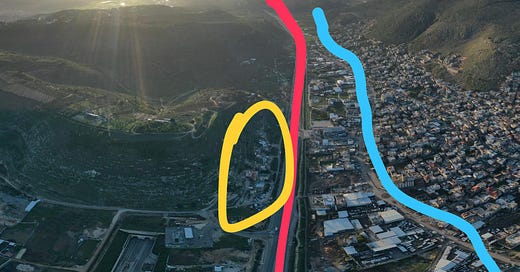Majd al-Kurum - Next steps in Israeli aggression
How roads make ghettos and set the stage for demolitions
The town of Majd al-Kurum lies a little inland of the city of Haifa, and only a little way south of the border with Lebanon. It is a Palestinian town with a Palestinian population, but owing to its location and the way the borders of the Israeli project in Palestine were set in 1948, it sits within the part of Palestine that the international community officially recognises as Israel, otherwise known as ‘48 Palestine. The town is significant in my own understanding of Palestine; I visited in 2018, and have a good friend who lives there, as her family has done for many generations, going back long before 1948 and the formal creation of the Israeli project.
Towns such as Majd al-Kurum have generally been able to maintain their Palestinian character, thanks to a combination of pure numbers and a culture of well-organised resistance each time Israeli encroachments began. The fact of being located inside Israeli territory, with Kurum residents given Israeli citizenship as “Palestinian Citizens of Israel”, technically provides a degree of legal protection and rights that should also—in theory —help in this process. This is why recent Israeli escalations against residents of Kurum are so troubling, even if such escalations—spreading outside of first Gaza and second the West Bank—did not go unpredicted.
Dheil Al-Mseel is a low-income neighbourhood purposefully cut from the main town of Kurum in 1997, when the Israelis built a new highway that bypassed the town itself, and set its route to deliberately isolate the residents of Dheil Al-Mseel. Roads famously play a significant role in shaping Israeli apartheid, with checkpoints used routinely to delay Palestinian journeys in the West Bank, while Jewish-only roads achieve a more obviously apartheid version of the same phenomenon.
The construction of the new Kurum road (marked in red, with the old road in blue and Dheil Al-Mseel in yellow), represents a different version of apartheid roadbuilding; here with the intention to isolate communities, and from that point turn them into ghettos. The Dheil Al-Mseel community already suffered from underdeveloped electricity and water infrastructure, while the isolation from the wider Kurum community eases the Israeli process of targeting homes in Dheil Al-Mseel for demolition, as it is currently doing.
That “Palestinian Citizens of Israel” are not fully protected by their citizenship from the abuse and discrimination meted out by Israelis to those without it is nothing new. Palestinian Bedouins of the Naqab Desert (called Negev by Israelis) are a prominent example of the same trend, where semi-nomadic communities constantly have their own farming and housing structures removed by officials enforcing Jewish apartheid upon them.
A version of this is now set to happen in Dheil Al-Mseel, where Israelis have set evacuation and demolition orders for eleven houses in the neighbourhood. All the houses have been there for decades, and predate the creation of the Israeli project in 1948. Eleven houses are now set to be demolished, each with several floors, totalling some twenty families to be evicted by the Israeli authorities. After the demolition, naturally, the families will all be homeless. That this can be done also to Palestinians with Israeli citizenship counters regular Israeli insistences that— outside of the Occupied Palestinian Territories of Gaza and the West Bank— the project is something resembling a functioning democracy, and not a Jewish apartheid.
The demolitions in Dheil Al-Mseel are significant also in the precedent they set. While genocidal Israeli atrocities against Palestinians began in Gaza, and subsequently moved to Palestinians in the West Bank (despite none of the Israeli justifications of “targeting Hamas” existing there), Palestinians have been under no illusions that the violence and demolitions being seen in both places would not fail to eventually move to ‘48 Palestine and even those with Israeli citizenship. Palestinians in all areas between the River and the Sea are fully aware that the Jewish supremacists who make up and run the project in Palestine make no distinction other than the “Children of Light” and “Children of Darkness” selection process with which they first publicly announced their genocide in Gaza.
That this is the fundamental and unalterable nature of the project of Jewish settlement in Palestine is also news to nobody who has paid any real attention, or visited Palestine with open eyes and ears. The one remaining question is at what point European and North American sponsors of the Israelis— for whom the veneer of a functioning society inside ‘48 Palestine is a key strategy of legitimisation— will demand some application of any basic standards above that of a Jewish-controlled apartheid, and if those standards can be applied in time to save hundreds of residents in Dheil Al-Mseel from being made homeless.




